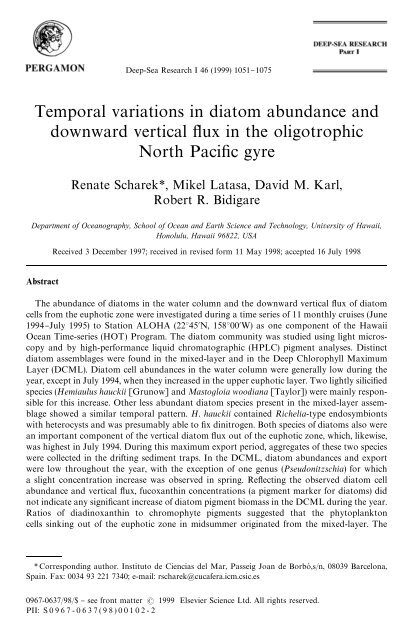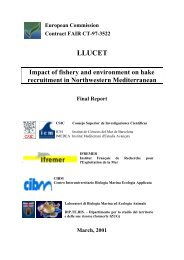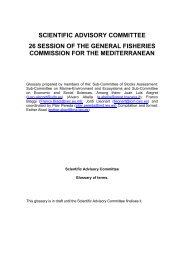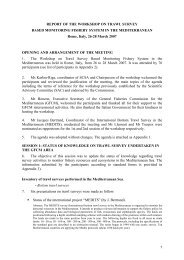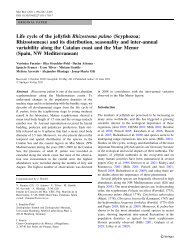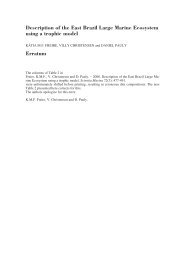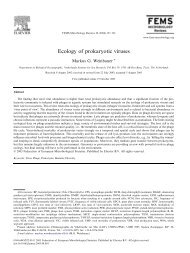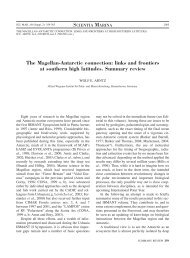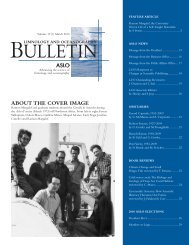Get pdf - Instituto de Ciencias del Mar
Get pdf - Instituto de Ciencias del Mar
Get pdf - Instituto de Ciencias del Mar
Create successful ePaper yourself
Turn your PDF publications into a flip-book with our unique Google optimized e-Paper software.
Deep-Sea Research I 46 (1999) 1051}1075<br />
Temporal variations in diatom abundance and<br />
downward vertical #ux in the oligotrophic<br />
North Paci"c gyre<br />
Renate Scharek*, Mikel Latasa, David M. Karl,<br />
Robert R. Bidigare<br />
Department of Oceanography, School of Ocean and Earth Science and Technology, University of Hawaii,<br />
Honolulu, Hawaii 96822, USA<br />
Received 3 December 1997; received in revised form 11 May 1998; accepted 16 July 1998<br />
Abstract<br />
The abundance of diatoms in the water column and the downward vertical #ux of diatom<br />
cells from the euphotic zone were investigated during a time series of 11 monthly cruises (June<br />
1994}July 1995) to Station ALOHA (22345N, 158300W) as one component of the Hawaii<br />
Ocean Time-series (HOT) Program. The diatom community was studied using light microscopy<br />
and by high-performance liquid chromatographic (HPLC) pigment analyses. Distinct<br />
diatom assemblages were found in the mixed-layer and in the Deep Chlorophyll Maximum<br />
Layer (DCML). Diatom cell abundances in the water column were generally low during the<br />
year, except in July 1994, when they increased in the upper euphotic layer. Two lightly silici"ed<br />
species (Hemiaulus hauckii [Grunow] and Mastogloia woodiana [Taylor]) were mainly responsible<br />
for this increase. Other less abundant diatom species present in the mixed-layer assemblage<br />
showed a similar temporal pattern. H. hauckii contained Richelia-type endosymbionts<br />
with heterocysts and was presumably able to "x dinitrogen. Both species of diatoms also were<br />
an important component of the vertical diatom #ux out of the euphotic zone, which, likewise,<br />
was highest in July 1994. During this maximum export period, aggregates of these two species<br />
were collected in the drifting sediment traps. In the DCML, diatom abundances and export<br />
were low throughout the year, with the exception of one genus (Pseudonitzschia) for which<br />
a slight concentration increase was observed in spring. Re#ecting the observed diatom cell<br />
abundance and vertical #ux, fucoxanthin concentrations (a pigment marker for diatoms) did<br />
not indicate any signi"cant increase of diatom pigment biomass in the DCML during the year.<br />
Ratios of diadinoxanthin to chromophyte pigments suggested that the phytoplankton<br />
cells sinking out of the euphotic zone in midsummer originated from the mixed-layer. The<br />
* Corresponding author. <strong>Instituto</strong> <strong>de</strong> <strong>Ciencias</strong> <strong>de</strong>l <strong>Mar</strong>, Passeig Joan <strong>de</strong> BorboH ,s/n, 08039 Barcelona,<br />
Spain. Fax: 0034 93 221 7340; e-mail: rscharek@cucafera.icm.csic.es<br />
0967-0637/98/$ } see front matter 1999 Elsevier Science Ltd. All rights reserved.<br />
PII: S 0 9 6 7 - 0 6 3 7 ( 9 8 ) 0 0 1 0 2 - 2
1052 R. Scharek et al. / Deep-Sea Research I 46 (1999) 1051}1075<br />
attenuation of the pigment vertical #uxes with <strong>de</strong>pth was signi"cantly lower for fucoxanthin,<br />
indicating a generally slower <strong>de</strong>cay of diatom #ux with <strong>de</strong>pth compared with other phytoplankton<br />
groups. Our "ndings suggest that, in the subtropical North Paci"c Ocean, summer<br />
conditions seem to favor the <strong>de</strong>velopment of selected species of diatoms in the mixed-layer and<br />
that these assemblages appear to be more important with regard to export production than<br />
those in the DCML. 1999 Elsevier Science Ltd. All rights reserved.<br />
1. Introduction<br />
In recent years consi<strong>de</strong>rable variability in phytoplankton productivity and standing<br />
stock, particle #ux and picoplankton population abundances has been observed in<br />
subtropical ocean gyres (Venrick et al., 1987; Lohrenz et al., 1992; Malone et al., 1993;<br />
Michaels et al., 1994; Campbell and Vaulot, 1993; Karl et al., 1995, 1996; Campbell<br />
et al., 1997). However, these observations did not invalidate the conceptual view of<br />
these environments as being relatively stable. In these areas, the phytoplankton<br />
populations, dominated by small prokaryotes and nano#agellates (Olson et al., 1990;<br />
Malone et al., 1993; Letelier et al., 1993; Campbell and Vaulot, 1993), are tightly<br />
coupled with their microzooplankton predators resulting in an e$cient recycling of<br />
carbon and related bioelements. These microbial loop intensive ecosystems preclu<strong>de</strong><br />
the existence of a traditional biological pump (Volk and Ho!ert, 1985) and typically<br />
export less than 10% of the particulate organic matter initially "xed through primary<br />
production (Lohrenz et al., 1992; Karl et al., 1996).<br />
However, Goldman (1988, 1993) suggested that diatoms, typically in very low cell<br />
abundances, might play an important role in new production and export of particulate<br />
organic carbon in oligotrophic oceanic habitats. Some mo<strong>de</strong>ls suggest that<br />
diatoms are the main phytoplankton producers of sinking particulate organic matter<br />
in oceanic habitats (Michaels and Silver, 1988; Dugdale et al., 1995). Thus, <strong>de</strong>spite<br />
their low abundances in the open ocean, diatoms could be disproportionate important<br />
for the export of particulate organic matter. Goldman proposed that possible<br />
episodic injections of new nutrients into the lower portion of the euphotic zone, the<br />
layer where in oligotrophic gyres the <strong>de</strong>ep chlorophyll maximum layer (DCML) is<br />
located, would lead to rapid diatom cell growth and coupled export. The aim of our<br />
study was to test this hypothesis, originally formulated for the oligotrophic Sargasso<br />
Sea, in the oligotrophic North Paci"c Gyre in the framework of the Hawaii Ocean<br />
Time-series (HOT) program (Karl and Lukas, 1996).<br />
Investigations were conducted during approximately monthly cruises for a period<br />
of one year in or<strong>de</strong>r to <strong>de</strong>tect possible short-term episodic or seasonal events<br />
of diatom growth. Diatom cell abundances in the water column and diatom cell #ux<br />
out of the euphotic zone were investigated with water samples obtained with CTDrosette<br />
casts and samples from #oating sediment traps, respectively. Our results<br />
provi<strong>de</strong> a revised view of the role of diatoms in oligotrophic oceanic habitats. We<br />
found that, in agreement with Goldman's hypothesis, diatoms are important for new<br />
production and carbon export. In contrast to the suggested importance of the<br />
assemblages at the base of the euphotic zone (Goldman, 1988, 1993), however, the
R. Scharek et al. / Deep-Sea Research I 46 (1999) 1051}1075 1053<br />
diatoms from the mixed-layer were mainly responsible for the export of particulate<br />
organic carbon.<br />
2. Material and methods<br />
2.1. Sampling<br />
Samples were obtained during a series of eleven cruises from June 1994 to July 1995<br />
to Station ALOHA (22345N, 158300W; Table 1). Seawater samples were collected in<br />
the water column from pre-<strong>de</strong>termined <strong>de</strong>pths using polyvinylchlori<strong>de</strong> sample bottles<br />
attached to a rosette frame and equipped with a CTD system and a #uorescence<br />
sensor (Karl and Lukas, 1996). Sample <strong>de</strong>pths exten<strong>de</strong>d between 5 and 165 m<br />
(Table 1), thus about reaching the calculated average <strong>de</strong>pth of the euphotic zone at<br />
Station ALOHA (0.05% surface PAR at 173 m; Letelier et al., 1996). Two subsamples<br />
were transferred to 250 ml brown glass bottles and "xed with hexamethylenetetramine-bu!ered<br />
20% (vol/vol) formal<strong>de</strong>hy<strong>de</strong> to a "nal concentration of 0.6% (vol/vol;<br />
Throndsen, 1978). For the enumeration of cyanobacterial endosymbionts in selected<br />
diatom species, the #uorochrome DAPI (Porter and Feig, 1980) was ad<strong>de</strong>d to one set<br />
of samples, because bright "eld or phase contrast microscopy cannot distinguish<br />
accurately the endosymbionts within Hemiaulus spp. (Heinbokel, 1986). These samples<br />
were subsequently "ltered onto 0.8 μm Nuclepore "lters ("ltration volume<br />
250 ml), mounted on microscopic sli<strong>de</strong>s and frozen at !203C.<br />
Floating sediment traps were <strong>de</strong>ployed at 165, 315 and 515 m for 72 h (Karl and<br />
Lukas, 1996). Single traps were <strong>de</strong>signated for each parameter in or<strong>de</strong>r to obtain<br />
enough material. Two traps were assigned for the collection of diatoms, two for<br />
biogenic silica, and four for phytoplankton pigments. Thus, there were eight traps at<br />
each <strong>de</strong>pth (except for cruises HOT 54 and HOT 55, when only two traps were<br />
assigned for pigments). The traps were "lled with a hypersaline (50 g NaCl l ad<strong>de</strong>d<br />
to surface seawater) formal<strong>de</strong>hy<strong>de</strong> solution ("nal concentration 0.37% vol/vol), except<br />
for two of the four pigment traps, which were <strong>de</strong>ployed with the same hypersaline<br />
solution but without "xative. Only these two non-"xed traps assigned for pigments<br />
were screened with a 335 μm Nitex mesh during <strong>de</strong>ployment. We chose to screen the<br />
non-"xed traps in or<strong>de</strong>r to avoid the entrance of swimmers and subsequent grazing on<br />
the fresh particulate organic material in the traps during <strong>de</strong>ployment, as our primary<br />
purpose in these "eld experiments was to characterize the photosynthetic pigments.<br />
Although some particulate material, e.g. aggregates, can be exclu<strong>de</strong>d by this treatment<br />
(Karl and Knauer, 1989), we did not observe statistical di!erences (Wilcoxon matched<br />
pairs test) between "xed (unscreened) and non-"xed (screened) pigment samples.<br />
However, HOT 54 and HOT 55 samples were not inclu<strong>de</strong>d in this test because there<br />
were no non-"xed (screened) pigment traps (Table 1).<br />
After retrieval of the trap array, the contents of the traps assigned for diatoms were<br />
concentrated onto 0.8 μm Nuclepore "lters with negative pressure to ca. 100 ml and<br />
"xed with hexamethylenetetramine bu!ered 20% (vol/vol) formal<strong>de</strong>hy<strong>de</strong> to a "nal<br />
concentration of 0.6% (vol/vol). The contents of the biogenic silica traps (ca. 1.5 l)
1054 R. Scharek et al. / Deep-Sea Research I 46 (1999) 1051}1075<br />
Table 1<br />
General information regarding cruises and investigations carried out at Station ALOHA (22345N, 158300W) between June 1994 and July 1995. Depth of the<br />
DCML was obtained by the #uorescence sensor during the CTD down-cast. Mixed-layer <strong>de</strong>pths are based on a 0.125 unit potential <strong>de</strong>nsity criterion (Levitus,<br />
1982). Mean mixed-layer <strong>de</strong>pths and standard <strong>de</strong>viation of the means were <strong>de</strong>termined from multiple casts on each cruise (generally, n'15)<br />
Samples and experiments<br />
Mean mixed-layer<br />
Cruise Cruise dates Water column, sample <strong>de</strong>pths (m) Floating sediment traps (165, 315, 515 m) <strong>de</strong>pth, $S.D. (m)<br />
HOT 54 June 17}22, 1994 5, 40, 60, 80, 125, 165 Only formal<strong>de</strong>hy<strong>de</strong>-"xed pigment traps 37 (6)<br />
HOT 55 July 22}27, 1994 5, 40, 70, 80, 130, 165 Only formal<strong>de</strong>hy<strong>de</strong>-"xed pigment traps 55 (8)<br />
HOT 56 Aug. 28}Sept. 2, 1994 5, 10, 20, 30, 40, 60, 80, 120, 165 Non-formal<strong>de</strong>hy<strong>de</strong>-"xed pigment traps 54 (8)<br />
only in 165 m<br />
HOT 57 Sept. 21}26, 1994 5, 10, 20, 30, 40, 70, 80, 110, 165 52 (6)<br />
HOT 58 Oct. 13}18, 1994 5, 10, 20, 30, 40, 70, 80, 110, 165 In 515 m only non-formal<strong>de</strong>hy<strong>de</strong>-"xed 61 (13)<br />
pigment traps<br />
HOT 59 Nov. 17}22, 1994 5, 10, 20, 30, 40, 80, 100, 165 No sediment traps <strong>de</strong>ployed 91 (7)<br />
HOT 60 Febr. 4}9, 1995 5, 10, 20, 30, 40, 60, 80, 115, 165 53 (12)<br />
HOT 61 <strong>Mar</strong>ch 2}7, 1995 5, 10, 20, 30, 40, 60, 80, 105, 165 No sediment traps <strong>de</strong>ployed 42 (9)<br />
HOT 62 April 4}9, 1995 5, 10, 20, 30, 40, 60, 80, 125, 140, 165 Shallowest traps <strong>de</strong>ployed in 180 m, 51 (9)<br />
one bSi trap (180 m) lost<br />
HOT 63 May 5}10, 1995 5, 10, 20, 35, 50, 80, 115, 165 45 (11)<br />
HOT 64 July 28}Aug. 2, 1995 5, 25, 40, 90, 100, 150 Traps only in 165 m, for diatom species 42 (8)<br />
composition<br />
Sample <strong>de</strong>pths within the <strong>de</strong>ep chlorophyll maximum layer (DCML).
were "ltered onto Nuclepore "lters and frozen at !203C. We chose a poresize of<br />
0.8 μm in or<strong>de</strong>r to facilitate passage of the brine solution through the "lters. We<br />
estimate the contribution of the non-retained (0.8 μm size fraction to total settling<br />
biogenic silica particles to be only a few percent, because biogenic silica particles in<br />
this size range have negligible settling velocities (Conley and Scavia, 1991). Pigment<br />
traps were "ltered with positive pressure onto Whatman GF/F "lters and subsequently<br />
stored in liquid nitrogen until analysis.<br />
2.2. Sample analyses<br />
R. Scharek et al. / Deep-Sea Research I 46 (1999) 1051}1075 1055<br />
Diatom cells concentrated onto Nuclepore "lters were examined for cyanobacterial<br />
endosymbionts using a compound microscope (Zeiss) equipped with UV epi-illumination<br />
and the respective "lter sets for #uorescence of DAPI and auto#uorescence of<br />
chlorophyll and phycoerythrin.<br />
Diatom cell counts were performed using an inverted microscope (Zeiss) equipped<br />
with bright "eld and phase contrast objectives according to the method of UtermoK hl<br />
(1958; settling volume 100 ml). Diatom cells were i<strong>de</strong>nti"ed to genus and, if possible, to<br />
species. Plasma content and damage of frustules were recor<strong>de</strong>d, and cell sizes were<br />
measured. Recognizable half frustules were counted, divi<strong>de</strong>d by two and ad<strong>de</strong>d to the<br />
number of intact empty cells of the respective taxa. Besi<strong>de</strong>s diatoms, other protists<br />
with silica skeletons (radiolaria and silico#agellates) and trichomes of ¹richo<strong>de</strong>smium<br />
spp. (cyanobacteria) were enumerated. Phytoplankton pigments were measured using<br />
high performance liquid chromatography according to Latasa et al. (1996) and<br />
An<strong>de</strong>rsen et al. (1996). Biogenic silica was measured with the sequential leaching<br />
technique <strong>de</strong>scribed by DeMaster (1981).<br />
3. Results<br />
3.1. Diatom cell concentrations in the water column<br />
The microphytoplankton ('20 μm) assemblages in the mixed-layer were di!erent<br />
from those in the DCML throughout the year. This di!erence was re#ected not only<br />
by the distribution of diatom species but also by the distribution of ¹richo<strong>de</strong>smium<br />
spp. trichomes in each layer (Tables 2 and 3).<br />
A similar distinction between a shallow and a <strong>de</strong>ep water phytoplankton assemblage<br />
was found by Venrick (1982, 1988, 1992) at other locations in the subtropical<br />
North Paci"c Ocean near 283N, 1553W. In addition, some diatom key species <strong>de</strong>"ned<br />
by Venrick (1988) for the shallow and <strong>de</strong>ep assemblages were found in the same<br />
assemblages in this study (Table 2).<br />
Concentrations of diatom cells were generally low throughout the year. No spring<br />
increase was observed in the mixed-layer (Fig. 1). In the DCML, a slight increase in<br />
concentration was observed for only one genus, Pseudonitzschia, in <strong>Mar</strong>ch (Table 2).<br />
However, we recor<strong>de</strong>d a conspicuous increase in diatom concentration particularly in<br />
the mixed-layer during the July HOT 55 cruise (Fig. 1). Primarily responsible for this
1056 R. Scharek et al. / Deep-Sea Research I 46 (1999) 1051}1075<br />
Table 2<br />
Most important diatom species occurring at Station ALOHA from June 1994 until July 1995; likewise microphytoplanktonic cyanobacteria and silico#agellates are<br />
presented. Respective habitats, minimum and maximum abundances of full cells, and seasonal distribution and export patterns with minimum and maximum #uxes<br />
of full cells are indicated<br />
Cells l Exported<br />
mixed-layer Cells l cells m d<br />
Distribution pattern (5 m) DCML Export pattern (avg. in 165 m)<br />
Main habitat temporal variation min.}max. min.}max. temporal variation min.}max.<br />
Mastogloia woodiana Mixed layer Max. July 1994 (10}2340 (10}20 Max. July 1994 (100}4,017,450<br />
Hemiaulus hauckii Mixed layer Max. July 1994 (10}960 (10}30 Max. July 1994 (100}1,231,725<br />
Small fusiform pennate Mixed layer Max. July 1995, max. Nov. 1994 (10}510 (10}20 Max. July 1995 (100}7728<br />
(203.5 μm)<br />
Mastogloia rostrata Mixed layer Max. Aug./Sept. 1994 (10}90 (10}(10 Max. July 1994, (100}7670<br />
Aug./Sept. 1994<br />
Hemiaulus other spp. Mixed layer Max. Sept. 1994, max. July 1995 (10}10 (10}(10 Max. July 1995 (100}2135<br />
Rhizosolenia cf. clevei Mixed layer No distinct maximum observed (10}40 (10}(10 Max. July 1994, (100}1629<br />
var. communis Aug./Sept. 1994<br />
Guinardia cylindrus Mixed layer No distinct maximum observed (10}50 (10}(10 No distinct maximum (100}(100<br />
observed<br />
Rhizosolenia other spp./ Mixed layer and DCML No distinct maximum observed (10}(10 (10}30 Max. June 1994, (100}1046<br />
Proboscia spp. July 1994<br />
Cylindrotheca closterium Mixed layer and DCML No distinct maximum observed (10}430 (10}270 Max. May 1995 (100}2,041,953<br />
Nitzschia bicapitata group Mixed layer and DCML No distinct maximum observed (10}190 (10}60 No distinct maximum (100}94,562<br />
observed<br />
¹halassionema cf. bacillare DCML No distinct maximum observed (10}(10 (10}50 No distinct maximum 397}13,022<br />
observed<br />
Pseudonitzschia spp. DCML Max. <strong>Mar</strong>ch 1995 (10}(10 (10}380 Max. June 1994 (100}46,841<br />
¹richo<strong>de</strong>smium spp. Mixed layer Max. July 1994, Aug./Sept. 1994 (10}670 (10}(10 Max. Aug./Sept. 1994 (100}120,540<br />
(cyanobact.) trich. trich.<br />
Dictyocha spp. Mixed layer and DCML No distinct maximum observed (10}110 (10}130 No distinct maximum 4612}25,236<br />
(crysophyte) observed<br />
Classi"ed by Venrick (1988) as key species for the speci"c habitat in the subtropical North Paci"c Ocean.
R. Scharek et al. / Deep-Sea Research I 46 (1999) 1051}1075 1057<br />
Table 3<br />
Abundances of ¹richo<strong>de</strong>smium spp. trichomes in the euphotic zone from June 1994 through July 1995 expressed as <strong>de</strong>pth integrals for either the mixed layer (0 m<br />
to base of mixed layer) or the <strong>de</strong>ep layer (base of mixed layer to 165 m); the latter inclu<strong>de</strong>s the DCML. The respective mixed-layer <strong>de</strong>pths and zones of the DCML<br />
are indicated in Table 1. Furthermore, vertical #ux of trichomes in the two respective traps at 165, 315, and 515 m. No traps could be <strong>de</strong>ployed during HOT 59<br />
and HOT 61; during HOT 64 traps were only <strong>de</strong>ployed at 165 m<br />
¹richo<strong>de</strong>smium trichomes<br />
(m) (m) Flux Flux Flux Flux Flux Flux<br />
euph. zone euph. zone (m d) (m d) (m d) (m d) (m d) (m d)<br />
Cruise Cruise dates mixed-layer <strong>de</strong>ep layer 165 m I 165 m II 315 m I 315 m II 515 m I 515 m II<br />
HOT 54 June 17}22, 1994 0 0 0 0 0 0 0 0<br />
HOT 55 July 22}27 8,358,335 600,000 0 0 0 0 0 0<br />
HOT 56 Aug. 28}Sept. 2 11,948,637 160,909 135,205 105,875 11,287 13,910 9777 795<br />
HOT 57 Sept. 21}26 2,520,000 0 1419 1242 0 3282 0 0<br />
HOT 58 Oct. 13}18 75,000 0 9005 0 0 0 948 0<br />
HOT 59 Nov. 17}22 100,000 0 n. d. n. d. n. d. n. d. n. d. n. d.<br />
HOT 60 Febr. 4}9, 1995 150,000 550,000 812 1083 2257 0 0 0<br />
HOT 61 <strong>Mar</strong>ch 2}7 0 0 n. d. n. d. n. d. n. d. n. d. n. d.<br />
HOT 62 April 4}9 0 0 11,058 (180 m) 0 (180 m) 0 1663 0 0<br />
HOT 63 May 5}10 2,925,000 0 2290 4090 0 0 0 0<br />
HOT 64 July 28}Aug. 2 900,000 0 0 0 n. d. n. d. n. d. n. d.
1058 R. Scharek et al. / Deep-Sea Research I 46 (1999) 1051}1075<br />
Fig. 1. Diatom cell abundance in the euphotic zone from June 1994 through July 1995, expressed as <strong>de</strong>pth<br />
integrals for either the mixed-layer (0 m to base of mixed-layer) or the <strong>de</strong>ep layer from the base of the<br />
mixed-layer to 165 m; the latter inclu<strong>de</strong>s the DCML. The respective mixed-layer <strong>de</strong>pths and zones of the<br />
DCML are indicated in Table 1. The upper graph shows full, the lower graph shows empty frustules.<br />
increase were the species Hemiaulus hauckii [Grunow] and Mastogloia woodiana<br />
[Taylor] (Fig. 2). These two species were clearly more abundant in the mixed-layer<br />
than in the DCML (Wilcoxon matched pairs test; p(0.05; n"11 pairs). Both diatom<br />
species are lightly silici"ed. Mixed-layer concentrations of other less abundant species<br />
of the genus Hemiaulus and Mastogloia were also slightly elevated in late summer 1994<br />
and July 1995 (Table 2). Moreover, numbers of ¹richo<strong>de</strong>smium spp., which were<br />
primarily found in the mixed-layer, also increased in July and August/September 1994<br />
(Tables 2 and 3).<br />
One year later (July 1995; HOT 64 cruise), total diatom abundance in 0}165 m was<br />
somewhat elevated, but not due to an increase of Hemiaulus hauckii and Mastogloia
R. Scharek et al. / Deep-Sea Research I 46 (1999) 1051}1075 1059<br />
Fig. 2. Abundances of Hemiaulus hauckii, Mastogloia woodiana and all other diatoms in the water column<br />
from June 1994 through July 1995 expressed as <strong>de</strong>pth integrals from 0 to 165 m. Upper and lower graph as<br />
in Fig. 1.<br />
woodiana (Fig. 2). Mixed-layer diatom abundances were third highest in that<br />
month and second highest in November 1994. In both months a small fusiform<br />
pennate diatom was dominant in the mixed-layer assemblage and was responsible<br />
for 37 and 26% of the mixed-layer diatom cell stock in July and November<br />
(Table 2).<br />
Investigation of water column samples using epi#uorescence microscopy revealed<br />
that during the whole year nearly all plasma containing cells of Hemiaulus hauckii<br />
carried one or two Richelia-type endosymbionts with heterocysts. Most cells of the<br />
less abundant species of the genus Hemiaulus (H. sinensis and H. membranaceus) also<br />
contained endosymbionts. Occasionally, Richelia-type cells were observed as epiphytes<br />
on centric diatom cells, mainly Chaetoceros spp. Cells of Mastogloia woodiana
1060 R. Scharek et al. / Deep-Sea Research I 46 (1999) 1051}1075<br />
were sometimes <strong>de</strong>tected in aggregates together with coccoid cyanobacteria of a<br />
diameter of approximately 5 μm.<br />
3.2. Phytoplankton pigments in the water column<br />
Phytoplankton pigment measurements corroborated the diatom distribution<br />
patterns. Concentrations of fucoxanthin (Fuco) were low throughout the year<br />
(Fig. 3). The increases of the pigment markers 19-hexanoyloxyfucoxanthin (Hexfuco),<br />
19-butanoyloxyfucoxanthin (But-fuco), and divinyl chlorophyll a (DV chla) at<br />
the DCML horizon indicated that Haptophyceae, Pelagophyceae and Prochlorophyceae,<br />
respectively, were the main contributors to the elevated pigment biomass<br />
in that layer (Fig. 3). Fuco concentrations were low in the DCML, with two small<br />
maxima during HOT 61 and HOT 64. As these peaks coinci<strong>de</strong>d with elevated<br />
Hex-fuco and But-fuco concentrations and did not correspond with an increase in<br />
diatom numbers, they should be attributed to the distribution of Haptophyceae and<br />
Pelagophyceae. Both classes contain Fuco as a minor pigment, as well as other<br />
accessory pigments.<br />
During HOT 55 (July 1994), concentrations of Fuco increased three-fold in the<br />
lower part of the mixed-layer (Fig. 3). The concentrations of the pigment markers of<br />
the other two chromophyte groups (Hex-fuco and But-fuco), in contrast, did not show<br />
a parallel change (Fig. 3). As explained above, diatom cell concentrations in the<br />
mixed-layer were also enhanced; thus, the Fuco peak in July was evi<strong>de</strong>ntly caused by<br />
an increase of diatom biomass.<br />
3.3. Vertical yux of diatom cells<br />
The vertical #ux of diatom cells and frustules out of the surface layer re#ected water<br />
column diatom abundances and, therefore, was highest in July 1994 (HOT 55) at all<br />
collection <strong>de</strong>pths (165, 315 and 515 m). Coinci<strong>de</strong>nt with the species distribution in the<br />
water column, H. hauckii and M. woodiana were also the most abundant species of<br />
diatoms in the sediment traps during this period (Fig. 4). Microscopic observations<br />
showed that part of the cells of these two species were removed from the mixed-layer<br />
as aggregates.<br />
Vertical #ux of most of the other less abundant diatom species of the mixed-layer<br />
assemblage and of ¹richo<strong>de</strong>smium spp. increased during summer or late summer<br />
(Tables 2 and 3). In May 1995 (HOT 63 cruise) high cell #uxes of Cylindrotheca<br />
closterium were observed, but solely in the shallowest sediment traps of 165 m <strong>de</strong>pth,<br />
making up 88% (average) of total diatom cell #ux (Fig. 4 and Table 2). However, this<br />
species, whose habitat was both the mixed-layer and the DCML, did not reveal<br />
elevated concentrations in the water column in this month.<br />
<br />
Fig. 3. Concentrations of phytoplankton pigments in the water column from 0 to 200 m from June 1994<br />
through July 1995. The graphs show from top to bottom: TChl a (total chlorophyll a: monovinyl<br />
chlorophyll a plus divinyl chlorophyll a), Fuco, Hex-fuco, But-fuco and DV chl a.
R. Scharek et al. / Deep-Sea Research I 46 (1999) 1051}1075 1061
1062 R. Scharek et al. / Deep-Sea Research I 46 (1999) 1051}1075
R. Scharek et al. / Deep-Sea Research I 46 (1999) 1051}1075 1063<br />
From the DCML only the cell numbers of Pseudonitzschia spp. increased in <strong>Mar</strong>ch<br />
1995 (HOT 61). This genus showed a small maximum in vertical #ux in June 1994<br />
(HOT 54; Table 2). Unfortunately, we could not <strong>de</strong>termine whether there was an<br />
increase of total particulate matter #ux in late autumn or early spring because traps<br />
could not be <strong>de</strong>ployed during the cruises HOT 59 and HOT 61 due to inclement<br />
weather (Table 1).<br />
3.4. Vertical yux of phytoplankton pigments<br />
In general, the export #ux of Fuco from the surface layer was low throughout the<br />
year. However, there was a clear maximum of Fuco #ux in July 1994 (HOT 55),<br />
coinci<strong>de</strong>nt with the maximum observed in the mixed-layer of the water column<br />
(Figs. 3 and 5). This maximum #ux of Fuco did not correspond to a general increase in<br />
the #uxes of the pigment markers Hex-fuco, But-fuco and DV chl a (Fig. 5). Consequently,<br />
it appears that diatoms are selectively removed from the water column. The<br />
observed Fuco #ux pattern corroborated the diatom cell counts in the traps.<br />
We used the ratio of diadinoxanthin (Diadino; chromophyte photoprotectant<br />
pigment; Demers et al., 1991) to the sum of the chromophyte light harvesting pigments<br />
(But-fuco, Hex-fuco, Fuco) as an indicator of the origin of the trap material. These<br />
ratios were typically between 0.2 and 0.3 in the upper mixed-layer of the water<br />
column, in contrast to the relatively low ratios observed at the DCML ((0.1; Fig. 6).<br />
During the peak diatom #ux event of July, these ratios were elevated at all trap<br />
collection <strong>de</strong>pths (Fig. 6), suggesting that the phytoplankton cells sinking out of the<br />
euphotic zone were <strong>de</strong>rived from the mixed-layer and not from the DCML.<br />
Attenuation of the vertical #ux of total chlorophyll a (TChl a: monovinyl chlorophyll<br />
a plus divinyl chlorophyll a) and pigment markers Fuco, But-fuco, and Hex-fuco<br />
with <strong>de</strong>pth can be <strong>de</strong>scribed as a function of <strong>de</strong>pth with the negative exponential<br />
function<br />
F "F e,<br />
<br />
where F is the estimated pigment #ux at 165 m, &&a'' is the estimated attenuation<br />
<br />
coe$cient and z is <strong>de</strong>pth. The nonlinear mo<strong>de</strong>l was adjusted by using a quasi-Newton<br />
algorithm to minimize the loss function (least squares; Christian et al., 1997). The<br />
coe$cients &&a'' were in general smaller for Fuco than for the pigment markers of other<br />
phytoplankton taxonomic groups and for TChl a (Table 4). Bonferroni pairwise<br />
comparisons (n"23, 1 outlier removed) showed signi"cant di!erences (p(0.05)<br />
of &&a'' Fuco from &&a'' of the other two pigment markers (But-fuco and Hex-fuco)<br />
but not between the &&a'' of But-fuco and Hex-fuco (p'0.05). This implies longer<br />
<br />
Fig. 4. Vertical #ux of full and empty diatom frustules from June 1994 through July 1995 presented as<br />
#uxes of Hemiaulus hauckii, Mastogloia woodiana and all other diatoms. (a) #uxes of full cells in the two<br />
replicate traps at 165, 315, and 515 m; (b) #uxes of empty frustules at the same <strong>de</strong>pths. No traps could be<br />
<strong>de</strong>ployed during HOT 59 and HOT 61 (indicated by one asterisk); during HOT 64 traps were only <strong>de</strong>ployed<br />
at 165 m (two asterisks).
1064 R. Scharek et al. / Deep-Sea Research I 46 (1999) 1051}1075<br />
Fig. 5. Vertical #uxes of pigments at 165 (a), 315 (b), and 515 m (c), from June 1994 through July 1995 (cruises HOT 54 through HOT 64). Each "gure shows from<br />
toptobottom:#uxes of TChl a, Fuco,Hex-fuco,But-fuco,andDVchla. The hatched columns show the #uxes measured in the traps without "xative (&&live'',<br />
screened), the empty columns show the #uxes in the traps with "xative (unscreened); means of two traps #1 standard <strong>de</strong>viation are given. No pigment traps were<br />
<strong>de</strong>ployed during HOT 59, HOT 61 and HOT 64 (indicated by an asterisk).
R. Scharek et al. / Deep-Sea Research I 46 (1999) 1051}1075 1065<br />
Fig. 6. Ratios of Diadino to the sum of chromophyte pigment markers (Fuco, But-fuco, Hex-fuco) in the<br />
water column from 0 to 200 m from middle of June 1994 through end of July 1995 (left panel) and in the<br />
sediment traps at 165, 315, and 515 m, from June 1994 through May 1995 (right panel). Error bars represent<br />
1 standard <strong>de</strong>viation.<br />
solubilization length scales of particulate organic matter originating from diatoms,<br />
which could be a consequence of faster sinking speeds, higher resistance to microbial<br />
attack, or both.<br />
3.5. Vertical yux of biogenic silica<br />
Vertical #ux of biogenic silica out of the surface layer was highest throughout the<br />
summer at all trap <strong>de</strong>pths (165, 315, and 515 m; Fig. 7A). In or<strong>de</strong>r to estimate the<br />
contribution of intact diatom frustules (empty and full cells) to the #ux of biogenic<br />
silica out of the euphotic zone, we assumed an average Si content of 2 pmol diatom<br />
cell. This cellular Si content is meant as an approximation, since the sizes of the two<br />
dominant and the other diatom species were di!erent. Data of cellular Si content<br />
measurements with cultures of the two dominant species are unfortunately not<br />
available. We refer to Brzezinski (1985), where Si contents for diatoms of similar sizes<br />
and <strong>de</strong>grees of sili"cation are presented. Our assumption of 2 pmol cell is likely<br />
conservative; thus it does not overestimate the silica contribution of the intact diatom<br />
frustules.<br />
In July, intact diatom frustules provi<strong>de</strong>d 14, 32 and 4% of the silica #ux at 165, 315<br />
and 515 m, respectively; during the rest of the year these percentages were between<br />
(1 and 7% (Fig. 7B). In contrast to the sharp diatom #ux maximum, the maximum
1066 R. Scharek et al. / Deep-Sea Research I 46 (1999) 1051}1075<br />
Table 4<br />
Parameters estimated for the best "t of the nonlinear mo<strong>de</strong>l F "F e, using a quasi-Newton algorithm. The mo<strong>de</strong>l <strong>de</strong>scribes the attenuation of vertical<br />
<br />
#ux of TChl a and pigment markers Fuco, But-fuco, and Hex-fuco as a function of <strong>de</strong>pth, where F is the pigment #ux at 165 m in ng m d, a (m) isthe<br />
<br />
attenuation coe$cient and z is <strong>de</strong>pth (Christian et al., 1997). Seed values of the unknowns were the average #uxes at 165 m for F and 0.001 for the attenuation<br />
<br />
coe$cient a. a Fuco are signi"cantly di!erent from a But-fuco and a Hex-fuco (p(0.05; Bonferroni pairwise comparison)<br />
Fucoxanthin 19But-fucoxanthin 19Hex-fucoxanthin Total chlorophyll a<br />
F F F F F F F F <br />
Cruise Cruise dates n (seed) (estimate) a r (seed) (estimate) a r (seed) (estimate) a r (seed) (estimate) a r<br />
HOT 54 June 17}22, 6 1976 1932 0.00165 0.92 4128 3997 0.00353 0.92 9120 9025 0.00645 0.98 15789 15412 0.00526 0.93<br />
1994<br />
HOT 55 July 22}27 5 2474 2576 0.00112 0.44 1385 1376 0.00780 0.92 2940 2889 0.00641 0.94 9566 9793 0.00227 0.80<br />
HOT 56 Aug. 28} 6 475 468 0.00303 0.65 1190 1182 0.00760 0.85 2155 2134 0.00606 0.75 3937 3888 0.00286 0.86<br />
Sept. 2<br />
HOT 57 Sept. 21}26 12 242 239 0.00520 0.85 1197 1193 0.01058 0.97 2077 2058 0.00696 0.96 3422 3342 0.00521 0.89<br />
HOT 58 Oct. 13}18 10 272 261 0.00360 0.66 732 724 0.00778 0.90 2127 2064 0.00348 0.85 3801 3546 0.00158 0.43<br />
HOT 60 Febr. 4}9, 9 466 493 0.00090 0.18 1167 1105 0.00244 0.31 2080 2017 0.00384 0.74 4754 4576 0.00257 0.47<br />
1995<br />
HOT 62 April 4}9 12 373 398 0.00214 0.49 554 550 0.00796 0.98 1248 1245 0.00475 0.96 2531 2545 0.00279 0.48<br />
HOT 63 May 5}10 12 1462 1444 0.00568 0.94 2787 2786 0.01472 0.97 5491 5480 0.01053 0.97 8645 8566 0.00782 0.85<br />
Mean 968 976 0.00291 1643 1614 0.00780 3405 3364 0.00606 6556 6459 0.00379<br />
S.D. 877 892 0.00181 1207 1174 0.00383 2635 2618 0.00222 4510 4462 0.00210
R. Scharek et al. / Deep-Sea Research I 46 (1999) 1051}1075 1067<br />
Fig. 7. (A) Vertical #uxes of biogenic silica at 165, 315, and 515 m. (B) Estimated percentage contribution of<br />
intact diatom frustules (full and empty cells) to the vertical #uxes of biogenic silica at 165, 315, and 515 m<br />
(biogenic silica assumed, 2 pmol diatom cell). Indicated for each <strong>de</strong>pth are the mean of two traps #1<br />
standard <strong>de</strong>viation. No biogenic silica traps were <strong>de</strong>ployed during HOT 59, HOT 61 and HOT 64<br />
(indicated by an asterisk).<br />
of biogenic silica #ux during the July 1994 cruise (HOT 55; Fig. 7A) was relativly weak,<br />
which may re#ect the <strong>de</strong>gree of sili"cation of the sinking diatom species. Asi<strong>de</strong> from<br />
intact frustules, <strong>de</strong>bris of diatom frustules was always present in the trap samples. The<br />
respective and possibly changing contributions of diatom frustule <strong>de</strong>bris to the biogenic<br />
silica #ux during each trap exposure could not be estimated. Still, we found that the<br />
increased diatom cell #ux in July 1994 was obviously not averaged out by a minimum of<br />
vertical #ux of radiolarian skeletons during the summer #ux event (Fig. 8).<br />
We assume that, during the year, the pattern of the carbon contribution of intact<br />
diatom cells to the #ux of particulate organic carbon, and the pattern of the silica<br />
contribution of intact diatom frustules to the #ux of biogenic silica, were similar. Since
1068 R. Scharek et al. / Deep-Sea Research I 46 (1999) 1051}1075<br />
Fig. 8. Vertical #ux of radiolarian skeletons from middle June 1994 until end July 1995. Indicated for each<br />
<strong>de</strong>pth are the mean of two traps #1 standard <strong>de</strong>viation. No traps were <strong>de</strong>ployed during HOT 59 and HOT<br />
61 (indicated by one asterisk); during HOT 64 traps were only <strong>de</strong>ployed at 165 m (two asterisks).<br />
a consi<strong>de</strong>rable part of the #ux of diatom frustules occurred as empty cells (Fig. 4), we<br />
conclu<strong>de</strong> that intact diatoms contributed more to the vertical #ux of biogenic silica<br />
than to the vertical #ux of particulate carbon.<br />
4. Discussion<br />
4.1. Phytoplankton assemblages<br />
The distribution of pigments in the water column between June 1994 and July 1995<br />
con"rmed the year long dominance of picoeukaryotic and prokaryotic phytoplankton<br />
at Station ALOHA, as <strong>de</strong>scribed by Letelier et al. (1993). Likewise, they reported very<br />
low concentrations of Fuco, the pigment marker of diatoms (Fig. 3). It is remarkable<br />
that the Fuco maxima were almost always found in the upper layers, which was<br />
contrary to the vertical distributions of the dominant light-harvesting pigments, such<br />
as Hex-fuco, But-fuco, DV chl a and TChl a, with maxima at the DCML. The fact that<br />
the increase of pigment concentrations in the DCML is mainly due to an increase of<br />
pigment per cell (Falkowski and La Roche, 1991; Latasa et al., 1992; Campbell and<br />
Vaulot, 1993) could lead to an un<strong>de</strong>restimation of the importance of diatoms in the<br />
upper water column. On the other hand, the three-fold increase of Fuco in the lower<br />
mixed-layer during HOT 55 was not a photoadaptive response, because there was<br />
a similar increase in the abundance of diatom cells as <strong>de</strong>termined by light microscopy.<br />
Our results, obtained during a one year period, provi<strong>de</strong> a seasonal perspective to<br />
the predominantly summer observations of Venrick (1982, 1988, 1990, 1992) for a
R. Scharek et al. / Deep-Sea Research I 46 (1999) 1051}1075 1069<br />
station north of our study site. The two di!erent assemblages of microplankton found<br />
throughout the year in the mixed and <strong>de</strong>ep layers resembled those <strong>de</strong>scribed by<br />
Venrick for the eastern basin of the North Paci"c gyre, a result that provi<strong>de</strong>s a<br />
justi"cation for time and space extrapolation of our results to a much larger area of<br />
the North Paci"c. In this context, the most outstanding result of our investigations<br />
was the maximum concentration of diatom species H. hauckii and M. woodiana,<br />
present in the mixed-layer during the summer of 1994. Both species are large<br />
('20 μm), and H. hauckii is chain-forming, in contrast to the <strong>de</strong>licate, needle-like<br />
pennate diatoms found in the DCML. The large oceanic diatom species proposed by<br />
Goldman et al. (1992) and Goldman (1993) to be responsible for episodic production<br />
and vertical #ux in the Sargasso Sea, were present only in the mixed-layer at Station<br />
ALOHA. Furthermore, the species composition of diatoms sinking out of the euphotic<br />
zone clearly showed their origin from the mixed-layer and not from the DCML.<br />
Observations from previous and following years at Station ALOHA suggest that<br />
the event of July 1994 is a seasonal phenomenon rather than an episodic inci<strong>de</strong>nt (see<br />
Goldman 1988, 1993). And it appears that during our cruise in July1995 (HOT 64) H.<br />
hauckii and M. woodiana concentrations and export had not yet increased, because at<br />
the end of the following month Brzezinski et al. (1998) observed a mixed-layer bloom<br />
of these two species north of Hawaii. It seems that summer conditions favor the<br />
proliferation of species with certain physiological characteristics. Thus, H. hauckii<br />
carried cyanobacteria with heterocysts (cf. Richelia) as endosymbionts in very high<br />
frequencies. Other cyanobacteria (¹richo<strong>de</strong>smium spp. ) had a maximum abundance<br />
in the mixed-layer in summer and late summer and a maximum in vertical #ux in late<br />
summer (Tables 2 and 3). On Station ALOHA ¹richo<strong>de</strong>smium spp. is known to occur<br />
in higher <strong>de</strong>nsities in summer, and &&exten<strong>de</strong>d periods of water column strati"cation''<br />
seem to favor colony <strong>de</strong>velopment of this genus (Karl et al., 1992; Letelier and Karl,<br />
1996). Laboratory studies indicate suboptimal photosynthetic performance of some<br />
cyanobacteria un<strong>de</strong>r #uctuating irradiance (Ibelings et al., 1994). The lack of mixing<br />
(#uctuating irradiance) during calm periods may explain in part the success of<br />
cyanobacteria (and cyanobacteria-carrying diatoms) in stable strati"ed conditions at<br />
Station ALOHA.<br />
The capability of ¹richo<strong>de</strong>smium and Richelia endosymbionts in Hemiaulus hauckii<br />
(and other phytoplankton) to "x dinitrogen (Taylor et al., 1973; Villareal, 1991) may<br />
have important consequences in the biogeochemical #uxes of the area. For example,<br />
diatoms could bene"t either from their endosymbionts or from "xed nitrogen leaching<br />
out of ¹richo<strong>de</strong>smium spp. (Karl et al., 1992). In fact, at Station ALOHA nitrogen<br />
"xation seems to be an important mechanism of new production and nitrogen supply<br />
to the phytoplankton community (Karl et al., 1997). It also appears to play a role in<br />
particulate matter export, because Karl et al. (1996) have documented the presence of<br />
an export peak to the <strong>de</strong>ep ocean in late summer } early fall.<br />
The reasons for the particular proliferation of two diatom species as H. hauckii and<br />
M. woodiana are not clear yet. The iron requirements for diatoms exceed those of<br />
other phytoplankton groups and increase at sub-saturating growth irradiances<br />
(Sunda and Huntsman, 1995, 1997; Muggli and Harrison, 1997). Sunda and Huntsman<br />
(1995, 1997) have also shown that the growth of small cells is favoured un<strong>de</strong>r iron
1070 R. Scharek et al. / Deep-Sea Research I 46 (1999) 1051}1075<br />
limitation. Consequently, these authors hypothesize that small cells should dominate<br />
the DCML in open-oceanic waters because of the reduced light and low dissolved<br />
inorganic iron concentrations found at these <strong>de</strong>pths. At Station ALOHA, iron<br />
concentrations will be highest in the surface, because the main source of iron is<br />
atmospheric <strong>de</strong>position, and in summer, when the mixed-layer is shallowest (Table 1).<br />
The combination of relatively high iron concentrations and high photon #uxes might<br />
favour the growth of large diatoms, a result consistent with the predictions of Sunda<br />
and Huntsman (1997).<br />
By virtue of their silica-impregnated cell wall, diatoms have a silicate requirement<br />
that is not shared by most other groups of marine phytoplankton. Soluble reactive<br />
silica concentrations at Station ALOHA are very low, and it is not possible to obtain<br />
accurate measurements using standard methods. Brzezinski et al. (1998) found wi<strong>de</strong>spread<br />
substrate limitation of silica production in the central North Paci"c, except for<br />
the already mentioned bloom of H. hauckii and M. woodiana they observed at the end<br />
of August 1995 north of Hawaii. This bloom displayed very low half saturation<br />
constants (K <br />
around 0.55 μM). Evi<strong>de</strong>ntly, diatom bloom formation can be accomplished<br />
only by those species of the mid-ocean gyre assemblages that have a high<br />
a$nity for silicic acid or low Si cell quota.<br />
4.2. Vertical yux<br />
Microscopic observations of the microphytoplankton allowed us to follow the<br />
dynamics of the di!erent diatom species in the water column and during transit to the<br />
<strong>de</strong>ep ocean as sinking particles. During the #ux event, we saw in the sediment traps<br />
a numeric dominance of species from the mixed-layer relative to species from the<br />
DCML. The similarity of the Diadino to chromophyte-light-harvesting-pigments<br />
ratios in the upper layers and in the traps (Fig. 6) provi<strong>de</strong>d further evi<strong>de</strong>nce that the<br />
sinking diatoms were <strong>de</strong>rived from the mixed-layer. In spite of the high #ux of diatoms<br />
during July 1994, the proportion of sinking full diatom cells at 165 m in relation to the<br />
standing stock we <strong>de</strong>termined in the euphotic zone (0}165 m) was 1.8% d, slightly<br />
larger than the ca. 0.5% d observed during the rest of the year (except cruise HOT<br />
63, average 2.2% d). Thus, a massive sinking typical of the end of coastal diatom<br />
blooms did not occur. In addition, the speci"c export rate (d) of empty cells was not<br />
enhanced. However, this could be a sampling artefact, as export events are likely to<br />
have a shorter lifetime than the roughly monthly sampling resolution used in this<br />
study. The export peak of Cylindrotheca closterium observed in May 1995 (HOT 63;<br />
Fig. 4) could have been an event like this. On the other hand, the high variability of<br />
cell #ux in the two 165 m traps and the absence of a peak in the traps below points to<br />
a high <strong>de</strong>gree of patchiness of this C. closterium #ux.<br />
The mechanism of diatom cell removal from the surface layers is still not resolved.<br />
The diatom aggregates found in the traps in July 1994 might have been responsible for<br />
the enhanced export out of the mixed-layer. The proliferation and sinking of<br />
¹richo<strong>de</strong>smium spp. colonies and trichomes in late summer (Table 3) did not increase<br />
the proportion of sinking diatoms, thus reinforcing the i<strong>de</strong>a that the export mechanisms<br />
for each group are in<strong>de</strong>pen<strong>de</strong>nt.
R. Scharek et al. / Deep-Sea Research I 46 (1999) 1051}1075 1071<br />
On an annual basis, the export of biogenic silica at 165 m was 23.7 mmol m yr<br />
during our investigation period. This resembles the rate Brzezinski and Nelson (1995)<br />
measured on the BATS Hydrostation S at 150 m (47.6 mmol m yr), if we substract<br />
the contribution of a winter diatom bloom that was responsible for 62% of the<br />
Hydrostation S annual #ux. The peak of diatom cells sinking at Station ALOHA in<br />
July 1994 is not clearly recognizable in the biogenic silica #ux pattern. The estimated<br />
#ux contribution of intact diatom silica frustules to the total #ux of biogenic silica<br />
varies between each trap <strong>de</strong>pth because of the variable #ux of cells. This variability<br />
could be caused by aggregate formation of the dominant species. Unfortunately, the<br />
export of particulate carbon and particulate organic nitrogen could be measured only<br />
at 150 m for the July 1994 cruise (http://hahana.soest.hawaii.edu), and the #uxes at<br />
this <strong>de</strong>pth suggest a low removal rate of particulate organic matter by intact diatoms.<br />
Nevertheless, the estimated contributions to the biogenic silica #ux are based on numbers<br />
of intact cells and are probably an un<strong>de</strong>restimation, because a possible transport<br />
of broken diatom frustules (e.g. in mesozooplankton fecal pellets) was not consi<strong>de</strong>red.<br />
In contrast to other phytoplankton groups, the diatoms seem to stay more intact<br />
while sinking (Table 4). The similarity between the structures of Fuco and Fucorelated<br />
compounds (like But-fuco and Hex-fuco) supports similar biochemical<br />
<strong>de</strong>struction rates for these pigment markers. Thus, the lower attenuation coe$cients<br />
&&a'' for Fuco than for But-fuco and Hex-fuco imply that the role of diatoms in the<br />
transport of organic matter is more conspicuous at greater <strong>de</strong>pths, because lower &&a''<br />
coe$cients mean less <strong>de</strong>cay. This is also indicated by the greater importance of Fuco<br />
#ux with <strong>de</strong>pth (Fig. 5). The mean attenuation coe$cient &&a'' we calculated for TChl<br />
a (Table 4) is nearly as high as these coe$cients for particulate nitrogen and particulate<br />
phosphorus at Station ALOHA; and our mean coe$cient &&a'' for Fuco is nearly<br />
as low as the coe$cient for particulate carbon (Christian et al., 1997). These similarities<br />
con"rm the importance of diatoms as a vector for vertical carbon #ux to the <strong>de</strong>ep sea.<br />
Although at Station ALOHA the maximum #ux of diatoms out of the surface layer<br />
did not result in a large particulate organic carbon and biogenic silica #ux, we suggest<br />
that their impact at great <strong>de</strong>pths will be more pronounced because of their slower<br />
<strong>de</strong>cay and faster sinking speeds, in comparison to the numerically dominant picophytoplankton.<br />
Our results show that H. hauckii and M. woodiana could be very<br />
e!ective vectors of material export at Station ALOHA, and their abundance in the<br />
water column may <strong>de</strong>termine the export #uxes of particulate organic matter into the<br />
<strong>de</strong>ep ocean.<br />
Already in 1974, Venrick hypothesized that nitrogen "xation by the Rhizosolenia-<br />
Richelia symbiosis may promote blooms of other phytoplankton in the subtropical<br />
North Paci"c gyre (Venrick, 1974). It is noteworthy that the Rhizosolenia blooms she<br />
observed coinci<strong>de</strong>d with blooms of H. hauckii, but by that time the latter were not<br />
known to potentially contain Richelia in high frequencies (Heinbokel, 1986). The<br />
excretion of recently "xed nitrogen by Richelia in a Rhizosolenia-Richelia symbiosis<br />
was in<strong>de</strong>ed noted in cultures by Villareal (1990). He also proposed that the<br />
Hemiaulus-cyanobacteria symbiosis is a potentially important site of nitrogen "xation<br />
in oligotrophic seas (Villareal, 1992, 1994). The data presented here expand these<br />
notions. We found that diatom cell abundance and assemblage compositon can vary
1072 R. Scharek et al. / Deep-Sea Research I 46 (1999) 1051}1075<br />
Fig. 9. Integrated stocks of Fuco for the <strong>de</strong>pth regions 0}50 and 50}200 m at station ALOHA from 1988 to<br />
1996.<br />
consi<strong>de</strong>rably during the year in the central gyre of the North Paci"c. Diatom growth<br />
and export took place in the mixed-layer at Station ALOHA, in contrast to the<br />
hypothesis of Goldman (1988, 1993), who suggested that nutrient injections at the<br />
base of the euphotic zone could be the responsible mechanism for diatom growth and<br />
export in the oligotrophic ocean. Moreover, we report that diatom cell proliferation<br />
and accumulation occurred un<strong>de</strong>r strati"ed conditions, contrary to the traditional<br />
view of diatom cell proliferation following a mixing event. The nitrogen "xation<br />
capacity of the endosymbionts of H. hauckii can explain part of these ecological<br />
particularities because of their potential to use &&new'' nitrogen. However, it is clear<br />
that there should be more reasons for the diatom proliferation in the mixed-layer.<br />
At Station ALOHA, vertical carbon #ux out of the surface layer and the ratio<br />
between primary production and export <strong>de</strong>creased since the beginning of 1992 (Karl<br />
et al., 1996), and since middle of 1993 Fuco stocks, notably in the <strong>de</strong>eper layers, appear<br />
to be lower than during 1990}1992 (Fig. 9). The question remains open whether the<br />
assemblages and seasonal dynamics of the autotrophic biogenic Si producers also<br />
have changed. Our results suggest that key species with certain physiological,<br />
morphological and life history characteristics are selected by the seasonally and<br />
interannually changing environment of the North Paci"c subtropical gyre (Karl et al.,<br />
1995, 1997; Verity and Smetacek, 1996). Which selection factors are the most important<br />
and which organism properties are <strong>de</strong>cisive await further investigation.<br />
Acknowledgements<br />
We thank the HOT-WOCE program scientists and sta! and the o$cers and crew<br />
members of R.V. Moana =ave for support in the "eld and in the lab. Special thanks go
R. Scharek et al. / Deep-Sea Research I 46 (1999) 1051}1075 1073<br />
to Karen Selph for help and to Ursula Magaard and Georgia Tien for excellent<br />
technical assistance. We are grateful to Elizabeth (Pooh) Venrick for helping with<br />
diatom i<strong>de</strong>nti"cation. Dolors Blasco provi<strong>de</strong>d useful comments on an earlier version<br />
of the text. We thankfully acknowledge the suggestions of Tracy Villareal and one<br />
anonymous reviewer for improving the manuscript. R.S. was supported by a NSF<br />
grant awar<strong>de</strong>d for cooperative research between the University of Hawaii and the<br />
Alfred Wegener Institute in Bremerhaven, Germany (OCE94-13249; DMK, P.I.). The<br />
HOT program sampling and core measurements were supported by NSF grants<br />
OCE93-01368 (DMK, P.I.) and OCE93-15311 (RRB, P.I.). SOEST Publication<br />
4671 US-JGOFS Publication 450.<br />
References<br />
An<strong>de</strong>rsen, R.A., Bidigare, R.R., Keller, M.D., Latasa, M., 1996. A comparison of HPLC pigment signatures<br />
and electron microscopic observations for oligotrophic waters of the North Atlantic and Paci"c oceans.<br />
Deep-Sea Research II 43, 517}537.<br />
Brzezinski, M.A., 1985. The Si : C : N ratios of marine diatoms: interspeci"c variability and the e!ect of some<br />
environmental variables. Journal of Phycology 21, 345}357.<br />
Brzezinski, M.A., Nelson, D.M., 1995. The annual silica cycle in the Sargasso Sea near Bermuda. Deep-Sea<br />
Research I 42, 1215}1237.<br />
Brzezinski, M.A., Villareal, T.A., Lipschultz, F., 1998. Silica production and the contribution of diatoms<br />
to new and primary production in the central North Paci"c. <strong>Mar</strong>ine Ecology Progress Series<br />
167, 89}104.<br />
Campbell, L., Vaulot, D., 1993. Photosynthetic picoplankton community structure in the subtropical North<br />
Paci"c Ocean near Hawaii (station ALOHA). Deep-Sea Research I 40, 2043}2060.<br />
Campbell, L., Liu, H., Nolla, H.A., Vaulot, D., 1997. Annual variability of phytoplankton and bacteria in<br />
the subtropical North Paci"c Ocean at Station ALOHA during the 1991}1994 ENSO event. Deep-Sea<br />
Research I 44, 167}192.<br />
Christian, J.R., Lewis, M.R., Karl, D.M., 1997. Vertical #uxes of carbon, nitrogen, and phosphorus in the<br />
North Paci"c Subtropical Gyre near Hawaii. Journal of Geophysical Research 102 C7, 15667}15677.<br />
Conley, D.J., Scavia, D., 1991. Size structure of particulate biogenic silica in Lake Michigan. Journal of<br />
Great Lakes Research 17, 18}24.<br />
DeMaster, D.J., 1981. The supply and accumulation of silica in the marine environment. Geochimica et<br />
Cosmochimica Acta 45, 1715}1732.<br />
Demers, S., Roy, S., Gagnon, R., Vignault, C., 1991. Rapid light-induced changes in cell #uorescence and in<br />
xanthophyll-cycle pigments of Alexandrium excavatum (Dinophyceae) and ¹halassiosira pseudonana<br />
(Bacillariophyceae): a photo-protection mechanism. <strong>Mar</strong>ine Ecology Progress Series 76, 185}193.<br />
Dugdale, R.C., Wilkerson, F.P., Minas, H.J., 1995. The role of a silicate pump in driving new production.<br />
Deep-Sea Research I 42, 697}719.<br />
Falkowski, P.G., La Roche, J., 1991. Acclimation to spectral irradiance in algae. Journal of Phycology 27,<br />
8}14.<br />
Goldman, J.C., 1988. Spatial and temporal discontinuities of biological processes in pelagic surface waters.<br />
In: Rothschild, B.J. (Ed.), Toward a Theory on Biological-Physical Interactions in the World Ocean,<br />
Kluwer Aca<strong>de</strong>mic, Dordrecht, pp. 273}296.<br />
Goldman, J.C., 1993. Potential role of large oceanic diatoms in new primary production. Deep-Sea<br />
Research I 40, 159}168.<br />
Goldman, J.C., Hansell, D.A., Dennett, M.R., 1992. Chemical characterization of three large oceanic<br />
diatoms: potential impact on water column chemistry. <strong>Mar</strong>ine Ecology Progress Series 88, 257}270.<br />
Heinbokel, J.F., 1986. Occurrence of Richelia intracellularis (Cyanophyta) within the diatoms Hemiaulus<br />
hauckii and H. membranaceus o! Hawaii. Journal of Phycology 22, 399}403.
1074 R. Scharek et al. / Deep-Sea Research I 46 (1999) 1051}1075<br />
Ibelings, B.W., Kroon, B.M.A., Mur, L.R., 1994. Acclimation of photosystem II in a cyanobacterium and<br />
a eucaryotic green alga to high and #uctuating photosynthetic photon #ux <strong>de</strong>nsities, simulating light<br />
regimes induced by mixing in lakes. New Phytologist, 128, 407}424.<br />
Karl, D.M., Knauer, G.A., 1989. Swimmers: a recapitulation of the problem and a potential solution.<br />
Oceanography 2, 32}35.<br />
Karl, D.M., Lukas, R., 1996. The Hawaii Ocean Time-series (HOT) program: Background, rationale and<br />
"eld implementation. Deep-Sea Research II 43, 129}156.<br />
Karl, D.M., Letelier, R.M., Hebel, D.V., Bird, D.F., Winn, C.D., 1992. Tricho<strong>de</strong>smium blooms and new<br />
nitrogen in the North Paci"c Gyre. In: Carpenter, E.J., Capone, D.G., Rueter, J.G. (Eds.), <strong>Mar</strong>ine<br />
Pelagic Cyanobacteria; Tricho<strong>de</strong>smium and other Diazotrophs. Kluwer Aca<strong>de</strong>mic, Dordrecht, pp.<br />
219}237.<br />
Karl, D.M., Letelier, R.M., Hebel, D.V., Tupas, L.M., Dore, J.E., Christian, J.R., Winn, C.D., 1995.<br />
Ecosystem changes in the North Paci"c subtropical gyre attributed to the 1991-92 El Nin o. Nature 373,<br />
230}234.<br />
Karl, D.M., Christian, J.R., Dore, J.E., Hebel, D.V., Letelier, R.M., Tupas, L.M., Winn, C.D., 1996. Seasonal<br />
and interannual variability in primary production and particle #ux at Station ALOHA. Deep-Sea<br />
Research II 43, 539}568.<br />
Karl, D.M., Letelier, R.M., Tupas, L.M., Dore, J.E., Christian, J.R., Hebel, D.V., 1997. The role of nitrogen<br />
"xation in biogeochemical cycling in the subtropical North Paci"c Ocean. Nature 388, 533}538.<br />
Latasa, M., Estrada, M., Delgado, M., 1992. Plankton-pigment relationships in the Northwestern Mediterranean<br />
during strati"cation. <strong>Mar</strong>ine Ecology Progress Series 88, 61}73.<br />
Latasa, M., Bidigare, R.R., Ondrusek, M.E., Kennicutt II, M.C., 1996. HPLC analysis of algal pigments:<br />
a comparison exercise among laboratories and recommendations for improved analytical performance.<br />
<strong>Mar</strong>ine Chemistry 51, 315}324.<br />
Letelier, R.M., Karl, D.M., 1996. Role of ¹richo<strong>de</strong>smium spp. in the productivity of the subtropical North<br />
Paci"c Ocean. <strong>Mar</strong>ine Ecology Progress Series 133, 263}273.<br />
Letelier, R.M., Bidigare, R.R., Hebel, D.V., Ondrusek, M., Winn, C.D., Karl, D.M., 1993. Temporal<br />
variability of phytoplankton community structure based on HPLC pigment analysis. Limnology and<br />
Oceanography 38, 1420}1437.<br />
Letelier, R.M., Dore, J.E., Winn, C.D., Karl, D.M., 1996. Seasonal and interannual variations in photosynthetic<br />
carbon assimilation at Station ALOHA. Deep-Sea Research II 43, 467}490.<br />
Levitus, S., 1982. Climatological atlas of the world ocean. Prof. Pap. 13, National Oceanic and Atmospheric<br />
Administration, Rockville, <strong>Mar</strong>yland, 173 pp.<br />
Lohrenz, S.E., Knauer, G.A., Asper, V.L., Tuel, M., Michaels, A.F., Knap, A.H., 1992. Seasonal variability in<br />
primary production and particle #ux in the northwestern Sargasso Sea. U. S. JGOFS Bermuda Atlantic<br />
Time-series Study. Deep-Sea Research 39, 1373}1391.<br />
Malone, T.C., Pike, S.E., Conley, D.J., 1993. Transient variations in phytoplankton productivity at the<br />
JGOFS Bermuda time series station. Deep-Sea Research I 40, 903}924.<br />
Michaels, A.F., Silver, M.W., 1988. Primary production, sinking #uxes and the microbial food web.<br />
Deep-Sea Research 35, 473}490.<br />
Michaels, A.F., Knap, A.H., Dow, A.L., Gun<strong>de</strong>rsen, K., Johnson, R.J., Sorensen, J., Close, A., Knauer, G.A.,<br />
Lohrenz, S.E., Asper, V.A., Tuel, M., Bidigare, R.R., 1994. Seasonal patterns of ocean biogeochemistry at<br />
the U.S. JGOFS Bermuda Atlantic Time-series Study site. Deep-Sea Research I 41, 1013}1038.<br />
Muggli, D.L., Harrison, P.J., 1997. E!ects of iron on two oceanic phytoplankters grown in natural NE<br />
subarctic paci"c seawater with no arti"cial chelators present. Journal of Experimenal <strong>Mar</strong>ine Biology<br />
and Ecology 212, 225}237.<br />
Olson, R.J., Chisholm, S.W., Zettler, E.R., Altabet, M.A., Dusenberry, J.A., 1990. Spatial and temporal<br />
distributions of prochlorophyte picoplankton in the North Atlantic Ocean. Deep-Sea Research 37,<br />
1033}1051.<br />
Porter, K.G., Feig, Y.S., 1980. The use of DAPI for i<strong>de</strong>ntifying and counting aquatic micro#ora. Limnology<br />
and Oceanography 25, 943}948.<br />
Sunda, W.G., Huntsman, S.A., 1995. Iron uptake and growth limitation in oceanic and coastal phytoplankton.<br />
<strong>Mar</strong>ine Chemistry 50, 189}206.
R. Scharek et al. / Deep-Sea Research I 46 (1999) 1051}1075 1075<br />
Sunda, W.G., Huntsman, S.A., 1997. Interrelated in#uence of iron, light and cell-size on marine phytoplankton<br />
growth. Nature 390, 389}392.<br />
Taylor, B.F., Lee, C.C., Bunt, J.S., 1973. Nitrogen-"xation associated with the marine blue-green alga,<br />
¹richo<strong>de</strong>smium, as measured by the acetylene-reduction technique. Archive for Microbiology 88,<br />
205}212.<br />
Throndsen, J., 1978. Preservation and storage. In: Sournia, A. (Ed.), Phytoplankton Manual. Monographs<br />
on Oceanographic Methodology 6. UNESCO, Paris, pp. 69}74.<br />
UtermoK hl, H., 1958. Zur Vervollkommnung <strong>de</strong>r quantitativen Phytoplankton-Methodik. Mitteilungen <strong>de</strong>r<br />
Internationalen Verhandlung <strong>de</strong>r Limnologie 9, 1}38.<br />
Venrick, E.L., 1974. The distribution and signi"cance of Richelia intracellularis Schmidt in the North Paci"c<br />
Central Gyre. Limnology and Oceanography 19, 437}445.<br />
Venrick, E.L., 1982. Phytoplankton in an oligotrophic ocean: observations and questions. Ecological<br />
Monographs 52, 129}154.<br />
Venrick, E.L., 1988. The vertical distributions of chlorophyll and phytoplankton species in the North<br />
Paci"c central environment. Journal of Plankton Research 10, 987}998.<br />
Venrick, E.L., 1990. Phytoplankton in an oligotrophic ocean: species structure and interannual variability.<br />
Ecology 71, 1547}1563.<br />
Venrick, E.L., 1992. Phytoplankton species structure in the central North Paci"c: is the edge like the center?<br />
Journal of Plankton Research 14, 665}680.<br />
Venrick, E.L., McGowan, J.A., Hayward, T.L., 1987. Climate and chlorophyll a: long-term trends in the<br />
central Norh Paci"c Ocean. Science 238, 70}72.<br />
Verity, P.G., Smetacek, V., 1996. Organism life cycles, predation, and the structure of marine pelagic<br />
ecosystems. <strong>Mar</strong>ine Ecology Progress Series 130, 277}293.<br />
Villareal, T.A., 1990. Laboratory culture and preliminary characterisation of the nitrogen-"xing Rhizosolenia-Richelia<br />
symbiosis. P.S.Z.N. <strong>Mar</strong>ine Ecology 11, 117}132.<br />
Villareal, T.A., 1991. Nitrogen-"xation by the cyanobacterial symbiont of the diatom genus Hemiaulus.<br />
<strong>Mar</strong>ine Ecology Progress Series 76, 201}204.<br />
Villareal, T.A., 1992. <strong>Mar</strong>ine nitrogen-"xing diatom-cyanobacteria symbioses. In: Carpenter, E.J., Capone,<br />
D.G., Rueter, J.G. (Eds.), <strong>Mar</strong>ine Pelagic Cyanobacteria; Tricho<strong>de</strong>smium and other Diazotrophs.<br />
Kluwer Aca<strong>de</strong>mic, Dordrecht, pp. 163}175.<br />
Villareal, T.A., 1994. Wi<strong>de</strong>spread occurrence of the Hemiaulus-cyanobacterial symbiosis in the southwest<br />
North Atlantic Ocean. Bulletin of <strong>Mar</strong>ine Science 54, 1}7.<br />
Volk, T., Ho!ert, M.I., 1985. Ocean carbon pumps: analysis of relative strengths and e$ciencies in<br />
ocean-driven atmospheric CO <br />
changes. In: Sundquist, E.T., Broecker, W.S. (Eds.), The Carbon Cycle<br />
and Atmospheric CO <br />
: Natural Variations Archean to Present. American Geophysical Union, Washington,<br />
DC, pp. 99}110.


